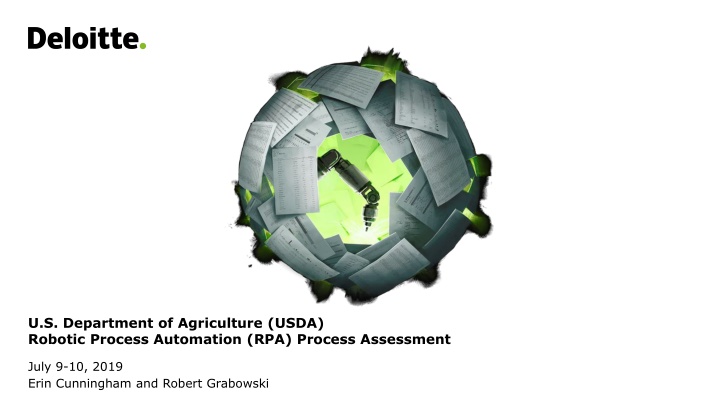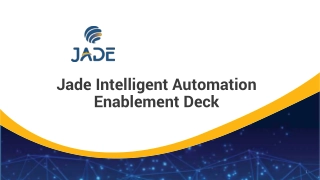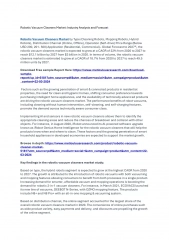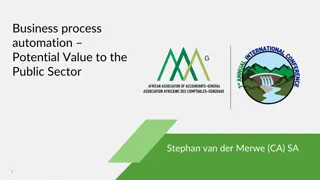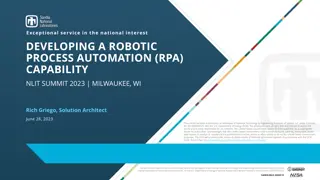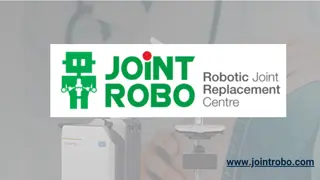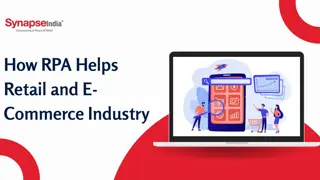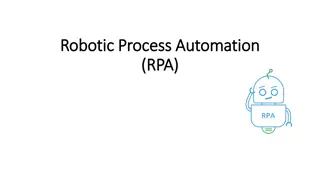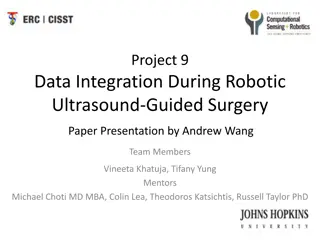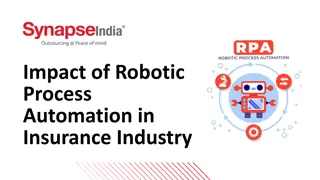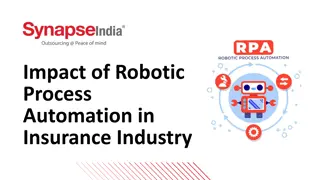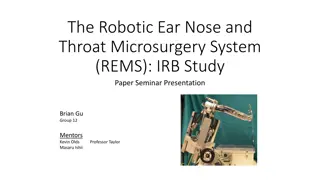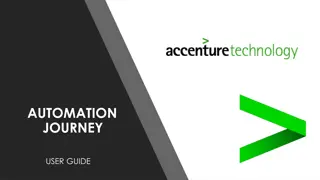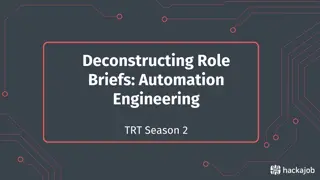USDA Robotic Process Automation (RPA) Assessment and Development Process
The USDA conducted a Robotic Process Automation (RPA) Process Assessment in July 2019, involving process robotics capabilities, development process under the Federated Model, and the lifecycle of a bot project. The RPA development process includes steps like requesting automation, process definition, deployment, validation, testing, and maintenance. The Federated Automation Development Process outlines steps from automation request to maintenance, involving customer engagement, development, validation, and ownership transitions.
Download Presentation

Please find below an Image/Link to download the presentation.
The content on the website is provided AS IS for your information and personal use only. It may not be sold, licensed, or shared on other websites without obtaining consent from the author.If you encounter any issues during the download, it is possible that the publisher has removed the file from their server.
You are allowed to download the files provided on this website for personal or commercial use, subject to the condition that they are used lawfully. All files are the property of their respective owners.
The content on the website is provided AS IS for your information and personal use only. It may not be sold, licensed, or shared on other websites without obtaining consent from the author.
E N D
Presentation Transcript
U.S. Department of Agriculture (USDA) Robotic Process Automation (RPA) Process Assessment July 9-10, 2019 Erin Cunningham and Robert Grabowski
RPA What It Is and Is Not Process Robotics is Process Robotics is not Software Mechanical / physical, walking, talking robots Rules-based Cognitive / AI / machine learning In production Conceptual A tool A system or application What Process Robotics can do Opening email and attachments Scraping data from the web Logging into web/enterprise applications Connecting to system APIs Making calculations Extracting structured data from documents Moving files and folders Copying and pasting Filling in forms Collecting social media statistics Reading and writing to databases Following if/then decisions/rules 3
USDA Development Process The Federated Model and the Lifecycle of a Bot Project 4
1 USDA RPA SMO Development Process Federated Automation Development Process The following steps represent the process the USDA RPA SMO will undertake when a customer requests process automation under the Federated model. More details on the process can be found on the subsequent slides. 1 3 4 6 8 1 2 5 7 Request for Automation Agreement to Proceed SMO Process Definition Deployment & Validation SMO Evaluation and Prioritization SMO Testing Operations & Maintenance Development All requestors complete a Questionnaire to be assessed by the USDA SMO Governance Board as an initial request for automation Upon approval, SMO Governance Board provides estimated LOE, prioritization, and estimated costs to requestor for agreement to proceed SMO SMO Quality Reviewer validates code and automation is deployed to production by the SMO Development Pod Requestors complete an Intake Form; SMO Leadership Team completes evaluation and provides estimated LOE, prioritization, and estimated costs to SMO Executive Committee for vote to proceed SMO Process Owner/ Requestor performs user acceptance testing (UAT) Automation is monitored and maintained by the USDA SMO Governance Board Development Pod performs detailed process walkthrough Development Pod builds the automation Customer Development Customer office takes ownership for automation development Automation Package provided to Customer Development Team, and templates are completed by Customer Development Team Continuous communication, bi-weekly status reporting, ad-hoc/informal reviews. 5 5
Lifecycle of a Bot Project 1. Process Identified / Request Submitted / SMO Review 2a. SMO Develops 2b. Requesting Org Develops LOE and development cost identified and agreed upon with requesting org SMO validates process and leases license to requesting org Requesting org provides process owner Requesting org develops with periodic reviews with the SMO SMO develops and reviews with requesting org Requesting org submits final code to SMO 3. SMO Validates / Deploys to Production / O&M 6
Does the Development Choice Make a Difference? 2b. Requesting Org Develops 2a. SMO Develops SMO leases license to requesting org SMO leadership completes requisite process design documents and identifies development pod Requesting org completes requisite process design documents, with SMO approval Development pod owns all development activities Requesting org designs and develops automation with SMO oversight Development pod drives User Acceptance Testing and review process, with input from the End Users SMO takes an active role in User Acceptance Testing Requesting org submits final code to SMO for review and deployment Development pod deploys automation 7
Process Assessment and Automation Design Best Practices to Support Effective Automation 8
Who Can Take Advantage of RPA at USDA? There are a wide variety of agencies and process functions able to take advantage of these new digital labor sources Phases Initiate Design Develop Operate Transfer Test Production Testing Project Work Plan Map Process Build Automation Test Solution Production Automation Primary Tasks Future State Process Troubleshoot Errors Regression Testing Automation Suitability Audit Logs Dashboard Governance Test Cases Deploy Changes O&M Implemen- tation Plan Process Metrics Path to Scale Documen- tation Managed Service Refine Business Case Process Design Documentation Training Plan Lessons Learned Provide advice, guidance and technical evaluations 9 Stakeholder Engagement
Identifying Processes for Automation Identifying candidates for process evaluation is driven by eight criteria: Number of systems used Transaction volume prone to errors or rework process predictability rules based exception handling manual work involved system upgrade timing controls importance 10
Evaluating Processes for Automation Process evaluation helps differentiate and prioritize candidates for automation. The following example demonstrates the analysis of six candidate processes to determine how fit the process is for Process Robotics. Business Processes Evaluation Criteria Candidate Process 1 Candidate Process 2 Candidate Process 3 Candidate Process 4 Candidate Process 5 Candidate Process 6 Number of Systems Used High High High Medium High High High High High High High Transaction Volume High 233K+ (43% of volume) 1.4M+ 104K+ 134K+ 89K+ High Prone to Errors or Rework Medium Low Low Low Low 25% of volume Process Predictability High Medium High High High Low Rules Based Exception Handling High Low-Medium High High Low Low Manual Work Involved High High High High High High System Upgrade Timing Weekly Monthly Semi-Annual Annual Monthly Annual Controls Importance High High High High Medium-High High 11
Sample Opportunity Scorecard Opportunity details: Complexity - # of tools required to execute the process, #of click by click actions required to execute process, To what extent does the process rely on paper, what percentage of process transactions can be completed using rules, what is the format and structure of data being used during process, what percentage of your work requires reading handwritten language. Opportunity Details: Process name: Authorization and Pricing Pends. Value: How often is the process performed? # of transactions that occur during the time frame selected above? How long does the process take to complete end to end? are you confident you can predict/anticipate volume of work What variation occurs between peak and low volume time periods. What percentage of the work requires correction due to errors? 12
Sample Prioritization Matrix High STRATEGIC (High Value, High Complexity) GOOD CANDIDATE (High Value, Low Complexity) Level of Value AVOID (Low Value, High Complexity) DEBATABLE (Low Value, Low Complexity) Low Level of Complexity 13
Key Process and Reporting Mechanisms for Robotics Projects at USDA 14
Key Documents to Capture the Pre-Development Information The SMO uses three key documents during the Pre-Development phase: Process Assessment Initial Questionnaire Basic, 10-question document to be completed by the End User End User receives as an email from the SMO RPA Inbox after submitting a request Answers Is the submitted process automatable? and Does the submitter understand the process? Process Assessment Intake Form More onerous tool that requires the assistance of a SMO member to complete. Completion occurs either in-person or through Skype. Answers Is the process a good candidate for automation? , What is the impact of the process for the organization? and What is the estimated level of effort to build the automation Process Design Document Defines the robotics process automation scope Describes the automated process step-by-step, to include high level process diagrams, technical systems, process triggers, and process inputs and outputs Provides a detailed keystroke mapping of the end result automated process Highlights variations to the previously agreed process 15
What goes into the Process Definition Document? Process Definition Document (PDD) Once the customer / requesting organization agrees to the evaluation and cost buildup, the SMO Development Team will conduct multiple process walk-throughs with the process owner(s). These include in-person walk-throughs, screen shares, recordings, etc. The complexity of the automation and the current state of process documentation will dictate the number of walk-throughs. 16
Questions? 17
